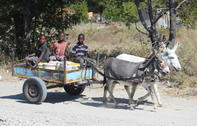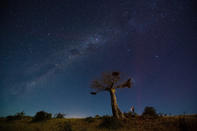The Great North Road

Klaas tapped the spent tobacco from his pipe into the coals and refilled it. He lit and puffed. “Bvekenya went to Pretoria and used up all his savings to buy a wagon, donkeys, provisions and a 303 rifle. Then he headed off on The Great North Road to seek his fortune. He would set up camp in Crook’s Corner, that odd wedge of land in the far northeast. It was home to many a curious and lawless character. Gunrunners, diamond prospectors, labour recruiters, you name it.”
“A beacon marked where South Africa, Mozambique and Zimbabwe came together. Bvekenya camped beside it with his herd of tame eland which provided milk for his coffee. When police of one country were looking for him for poaching or whatnot, he moved the beacon to place himself in another country. That way he didn’t have to break camp to elude the law! Slim, I tell you.”
“He had more adventures and scrapes than most: charged by tuskers, surrounded by lions, ambushed by locals, you name it. Ja, he was a character alright. . . .”
Climbing the koppie studded with paperbark false-thorn (Albizia tanganyicensis), next morning Klaas led us to a small enclosure adorned with rock art. Delicate figures stalked with bows and arrows; frozen antelope grazed unmolested on the rock face.
Further along the contour we found grain bins of clay moulded to a ledge overlooking the valley. “Clans must have used it as a hideaway or defensive position when threatened,” said Klaas. There were plenty of other hideouts and fortress koppies in the area. Later Klaas pointed out where Boers, led by the young Paul Kruger, had stormed a stronghold at night. Hundreds of defenders had jumped from the cliffs in the panicky darkness.
Our vehicles headed north through rural villages of the Makgabeng hills. Pedi rondavels, cactus groves, baobabs. Donkey carts were more prevalent than 4x4s. Some were elaborate affairs geared for rough terrain. At one crossroads a 16x18 (four donkeys) cut across our path. A wide-eyed 10-year old was standing in the cart brandishing a whip, Ben Hur style. His two toddler passengers laughed hysterically.
We drove via Blouberg Camp to reach the Botswana border post at Platjan with five minutes to spare. The road through Northern Tuli Game Reserve, was lovely in the late light. We paused at Solomon’s Wall, a dolerite dyke exposed where it crosses the Motloutse River. Over eons water has eroded the ironstone to reveal two walls resembling a battlement.
Tuli Game Reserve

Elephants moved against the sun kicking up scarlet dust, as we drove to an overnight spot beside the Limpopo. The Ivory Route tented camp (named Dongola) was not yet in operation, so we out spanned on the north bank where a trail camp is operated in association with Tumelo Game Lodge. As darkness fell Sannie became a little anxious. It was her first time alone in a tent in such close proximity to predators. Klaas and I began to rag her. “I’m not getting out of my tent to go to the toilet tonight. Not a chance!” she said. “I might just sleep in the Pajero?”
The Limpopo oozed between trees just metres from camp. Stars came out and drifted like candle decorations in the water. The night began to ring with a frog chorus. This was the river in a most placid of frames, for the Limpopo’s destructive nature is feared by those living along its banks. The Matebele call it iliMphopho, the river of rapid rising and falling. The Venda know it as Vhembe, the gatherer, while the Shangaans call it Methe, the swallower. Bvekenya was no stranger to its mood swings and was once trapped on an island for 27 days when it suddenly came down in flood. He lived on cane rats, bullfrogs (which apparently tasted like crayfish) and boiled wild spinach.
Klaas got the fire going and soon meat smells wafted through camp. A baboon became hysterical on the far bank, probably getting a hiding from an elder. Within an hour we’d polished off an amount of meat that would have embarrassed our city selves. Klaas picked a coal from the fire with his fingers and dropped it into his pipe. He puffed for some time, then cleared his throat. “You know, Bvekenya killed hundreds of elephants, but he never enjoyed watching them die. He always divided the meat among local people, so the animal never went to waste. He respected his prey: big tuskers who’d charge him like a tornado, flattening the bush.
“We’ve included the Tuli in our Ivory Route ’cause it’s thick with elephant and drew hunters from far and wide. A renegade named De Buys was the first big white hunter and arrived in 1809. He was fearless. He’d take down tuskers at close quarters with an ancient muzzleloader.”
A lion roared in the distance. “That sounded like a car,” said Sannie, unconvinced. We kept silent and Klaas smiled at me.
By Justin Fox